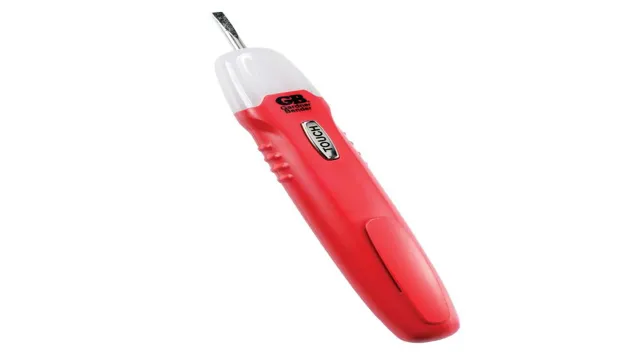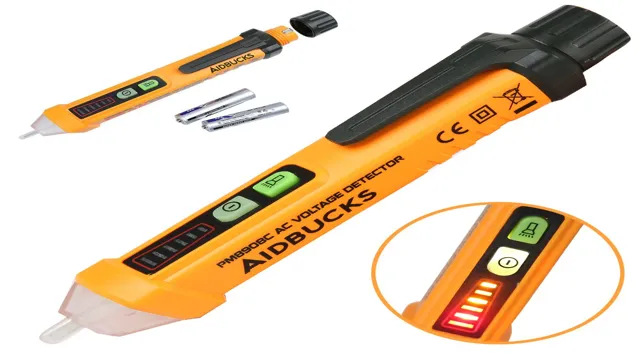How to Use Klein Tools Non Contact Voltage Tester for Accurate Electrical Testing

As a homeowner, safety should always be at the forefront of your mind, especially when it comes to electrical systems. One of the most important tools to have in your arsenal is a non-contact voltage tester. And when it comes to high-quality voltage testers, Klein Tools’ non-contact voltage tester is one of the best on the market.
But why should you consider investing in one? Well, imagine this: you’re working on a DIY project that involves working with electrical wiring. You touch a wire, and suddenly you feel a jolt of electricity coursing through your body. You could have just been electrocuted.
Scary thought, right? That’s where the non-contact voltage tester comes in. This tool allows you to check if a wire has an electrical charge without having to touch it, making it incredibly safe and easy to use. Plus, the Klein Tools’ non-contact voltage tester also has a flashlight feature, making it useful in dark areas.
Investing in a non-contact voltage tester is a small price to pay for the peace of mind it provides. And with the added benefits of the Klein Tools’ non-contact voltage tester, you can rest assured that you have a durable and reliable tool in your toolbox.
What is a Non-Contact Voltage Tester
If you’re looking to check for live electrical circuits without actually touching them, a non-contact voltage tester like the Klein Tools NCVT-1 is a great tool for the job. This easy-to-use device can alert you to the presence of voltage in wires, outlets, and other electrical equipment through a visual and audible indicator. Simply hold the tester near the source of voltage and it will indicate if voltage is present or not – without the need for any physical contact.
Plus, with its compact size and durable construction, the Klein Tools NCVT-1 is a reliable and convenient tool to keep in your toolbox. So, if you want to stay safe when working with electricity, this is one tool you won’t want to go without. And with a little practice and guidance on how to use Klein Tools non contact voltage tester, you’ll be able to work with electricity confidently and safely in no time!
Definition
A non-contact voltage tester is an electrical testing device that allows you to check for the presence of electricity without making physical contact with the electrical conductor. This type of tester is especially useful for electricians and DIY enthusiasts as it allows them to determine if a wire is “hot” or “live” without risking electrocution. Non-contact voltage testers work by detecting the electromagnetic field that surrounds a live electrical conductor when a voltage is present.
They come in different types, including pens and wands, and make an audible or visual signal to indicate the presence of electricity. Using a non-contact voltage tester is an easy and safe way to check for live wires and can help to prevent electrical accidents. Whether you are a professional electrician or a home DIYer, having a non-contact voltage tester in your toolkit is a must.

How does it work
A non-contact voltage tester is a handy tool used by electricians and DIY enthusiasts to detect the presence of electrical current in wires, cables, and appliances without physically touching or connecting to them. The tester uses a sensor or probe to pick up electromagnetic fields emitted by the current, and then indicates the presence of voltage through a visual or auditory signal. It’s a safe and convenient way to identify live wires and circuits, and can be particularly useful in situations where it’s difficult or dangerous to access electrical components.
Non-contact voltage testers come in different sizes and types, with varying levels of sensitivity and features. So, whether you’re planning to do some electrical repairs at home or simply want to check if a power outlet is active, a non-contact voltage tester can help you do the job more efficiently and with greater peace of mind.
Types of testers
A non-contact voltage tester is a type of tester that is used to detect the presence of electrical voltage without having to touch any wires or conductors. This type of tester works by detecting the electric field that is present around an object that is carrying electrical current. It does this by using a sensor that can detect the electric field and then transmitting a signal to an LED light or an audible alarm that will alert the user to the presence of voltage.
The advantage of using a non-contact voltage tester is that it eliminates the need for direct contact with live conductors, which can be dangerous and even deadly. Non-contact voltage testers are commonly used by electricians and other professionals who work with electrical equipment to ensure that circuits are properly shut off and to test for the presence of voltage before starting work.
Preparing the Voltage Tester
Before using the Klein Tools Non-Contact Voltage Tester, it’s important to first prepare the tool. Start by ensuring that the battery is properly inserted and charged. Next, double-check that the tester is functional by testing it on a known source of voltage.
This could be as simple as testing it on a power outlet or light switch. Once you know that it’s working properly, it’s time to make sure the area surrounding the object you intend to test is clear of any debris or obstacles that could impede the test. This includes things like nearby cords, cables, or other electrical equipment.
Finally, make sure you’re holding the tester properly, with your fingers away from the tip as you do not want to alter the test results due to any electrical signals your fingers may give off. With proper preparation, the Klein Tools Non-Contact Voltage Tester can help you quickly and easily identify the presence of voltage in any environment.
Check for damage
When you’re working with electrical systems, it’s important to make sure that everything is in good condition before you begin any work. One of the first steps to take is to prepare your voltage tester. This tool is essential for testing whether a live current is present in a particular circuit.
Before using the tester, it’s crucial to check it for any damages or wear and tear that could affect its performance. Look for any cracks or scratches on the tester’s body, as well as any signs of rust or corrosion on its probes. If you notice any issues, it’s better to replace the tester or fix the problem before using it.
Once you’ve checked and ensured that your voltage tester is in good condition, you’ll be able to use it with confidence and safety when checking electrical systems. So, always make sure to check your voltage tester before every use to protect yourself and others you’re working with.
Inserting batteries
To prepare your voltage tester for use, you will need to insert the batteries. Before doing so, make sure you have the appropriate batteries for your tester. Most voltage testers use AAA or AA batteries, but it’s always best to check the manufacturer’s instructions to be sure.
Once you have the right batteries, remove the cover of the tester by sliding it off or unscrewing it, depending on the model. Insert the batteries in the correct orientation, as indicated by the plus and minus signs on the battery compartment. Replace the cover and ensure that it snaps or screws back into place securely.
With the batteries now installed, your voltage tester is ready to go! Just remember to remove the batteries when not in use to avoid leakage and to prolong the battery life.
Turning on the tester
Before starting to use the voltage tester, it’s essential to prepare it properly. Firstly, you need to make sure that you have a good set of batteries installed to avoid any incorrect readings. Secondly, ensure that the tester is switched off before you start using it.
Once you’ve done this, you need to turn on the tester by using the power button on the device. It’s important to note that you might need to wait for a few seconds before you can see the display light up. Once the light appears, you’re ready to use the tester.
Using a voltage tester can be a bit intimidating, but taking the proper precautions will help avoid any accidents or potential issues. Before starting, you want to make sure the batteries are fresh and installed correctly to ensure the device has enough power to work as intended. Always double-check that the tester is switched off before attempting to turn it on.
After turning it on, don’t be alarmed if there is a slight delay before the light appears, as this is normal for most testers. Once you have the tester turned on, you’re ready to start checking for voltage levels.
Testing for Voltage
If you’re a DIYer or an electrician, having a reliable non-contact voltage tester like the Klein Tools NCVT can make all the difference in ensuring your safety while working with electrical systems. But knowing how to use the tool properly can be just as critical. To test for voltage, simply turn on the tester and hold it close to the outlet or wire you want to test.
If the tester beeps or lights up, it means there’s voltage present, and you should proceed with caution. But make sure to double-check with a contact tester or multimeter before starting any work, and always follow standard safety procedures to avoid electrical shock or injury. Using a Klein Tools non-contact voltage tester can give you greater peace of mind and confidence when working with electricity, as long as you use it correctly and responsibly.
Identifying hot wires and circuits
When it comes to identifying hot wires and circuits, testing for voltage is an essential step. Voltage is the measure of electrical energy that flows through a circuit, and it can be hazardous to work with if not handled properly. To test for voltage, you’ll need a device called a voltmeter or multimeter.
Simply turn the device on and set it to measure AC or DC voltage, depending on what you’re testing. Then, place the two probes of the device on either side of the wire or circuit you want to test. If the voltmeter reads a voltage, then you’ll know that the circuit is hot.
It’s important to note that you should never touch a wire or circuit while testing for voltage, as it can be dangerous or even deadly. Instead, use caution and follow proper safety protocols to ensure that you can identify hot wires and circuits safely and effectively.
Pointing the tester
When it comes to testing for voltage, it’s important to use the right tools and take proper safety precautions. One of the key tools for this task is a voltage tester, which can be used to detect electrical current in a wire or circuit. To use a voltage tester, first, make sure the power is turned off and the circuit is de-energized.
Then, insert the tester’s probes into the circuit to check for the presence of voltage. A voltage tester will typically emit a beeping or flashing signal if voltage is detected, making it easy to identify areas that may be unsafe to work on. It’s important to always follow proper safety protocols when working with electricity, including using gloves and safety glasses as necessary.
With the right tools and safety measures in place, testing for voltage can be a safe and effective way to identify potential electrical hazards and keep your workspace safe.
Interpreting the results
After conducting the necessary tests, we can determine whether or not the voltage in your electrical system is optimal. The results we obtain from these tests provide valuable insight into the state of your system and any issues that may arise in the future. If the voltage is too low, it can cause problems such as dimming lights or electrical appliances not working as efficiently as they could.
High voltage, on the other hand, can lead to damaged appliances and pose a safety hazard to individuals. Our team of experts can interpret the results of these tests and advise on the necessary steps to optimize the voltage in your system, ensuring that it runs smoothly, efficiently, and safely. So, if you suspect any issues with the voltage in your electrical system, don’t hesitate to give us a call today.
Safety Precautions
If you’re planning to use Klein Tools Non-Contact Voltage Tester, you must know certain safety precautions to avoid any electrical mishap. Firstly, always wear protective gloves and footwear while dealing with electrical equipment. Also, turn off the power source before using the tester.
Don’t touch any conductive surface or barrier when the tester is active. Additionally, avoid using the tester in wet or damp conditions and never use it near flammable or explosive substances. Lastly, never use the tester to check the voltage of the output of a transformer, as this may cause damage to the tester.
By following these safety measures, you can make sure that you have a safe and effective electrical testing experience with Klein Tools Non-Contact Voltage Tester.
Conclusion
In conclusion, using Klein Tools non-contact voltage tester is as easy as a breeze! Simply hold the tester close to the electrical wire or outlet you wish to test, and watch as the LED lights up and the tester beeps to indicate the presence of voltage. With its compact size and reliable accuracy, this tool is the perfect companion for anyone working with electricity. So, go ahead and “be a pro” with Klein Tools and keep your electrical work safe and efficient with their non-contact voltage tester!”
FAQs
What is the range of the Klein Tools Non-Contact Voltage Tester?
The range of the Klein Tools Non-Contact Voltage Tester is 12V to 1000V AC.
How do you use the Klein Tools Non-Contact Voltage Tester?
To use the Klein Tools Non-Contact Voltage Tester, simply hold the tester near the wire or outlet being tested and if voltage is present, a red light and audible alert will be triggered.
Can the Klein Tools Non-Contact Voltage Tester detect low voltage?
Yes, the Klein Tools Non-Contact Voltage Tester can detect low voltage starting at 12V AC.
How long does the battery last in the Klein Tools Non-Contact Voltage Tester?
The battery life of the Klein Tools Non-Contact Voltage Tester lasts up to 5 hours of continuous use.
Is the Klein Tools Non-Contact Voltage Tester water-resistant?
No, the Klein Tools Non-Contact Voltage Tester is not water-resistant and should not be used in wet environments.
Does the Klein Tools Non-Contact Voltage Tester have a warranty?
Yes, the Klein Tools Non-Contact Voltage Tester has a limited lifetime warranty.
What is the size and weight of the Klein Tools Non-Contact Voltage Tester?
The Klein Tools Non-Contact Voltage Tester is 5.74 inches long, 0.68 inches wide, and weighs 0.05 pounds.







